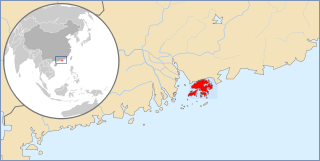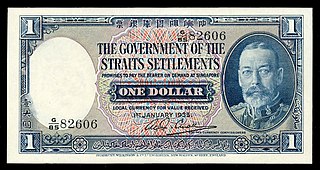Related Research Articles

The Malaysian ringgit is the currency of Malaysia. It is divided into 100 sen (cents). The ringgit is issued by Bank Negara Malaysia, the central bank of Malaysia.

The Brunei dollar, has been the currency of the Sultanate of Brunei since 1967. It is normally abbreviated with the dollar sign $, or alternatively B$ to distinguish it from other dollar-denominated currencies. It is divided into 100 sen (Malay) or cents (English). The Brunei dollar is issued by the Autoriti Monetari Brunei Darussalam.

The Singapore dollar is the official currency of Singapore. It is divided into 100 cents. It is normally abbreviated with the dollar sign $, or S$ to distinguish it from other dollar-denominated currencies. The Monetary Authority of Singapore issues the banknotes and coins of the Singapore dollar.

The Macau pataca or Macanese pataca is the currency of Macau. It is subdivided into 100 avos, with 10 avos called ho (毫) in Cantonese. The abbreviation MOP$ is commonly used.

Silver certificates are a type of representative money issued between 1878 and 1964 in the United States as part of its circulation of paper currency. They were produced in response to silver agitation by citizens who were angered by the Fourth Coinage Act, which had effectively placed the United States on a gold standard. The certificates were initially redeemable for their face value of silver dollar coins and later in raw silver bullion. Since 1968 they have been redeemable only in Federal Reserve Notes and are thus obsolete, but still valid legal tender at their face value and thus are still an accepted form of currency.
The colón is the currency of Costa Rica. It was named after Christopher Columbus, known as Cristóbal Colón in Spanish.

The Fijian dollar has been the currency of Fiji since 1969 and was also the currency between 1867 and 1873. It is normally abbreviated with the dollar sign $, or alternatively FJ$ to distinguish it from other dollar-denominated currencies. It is divided into 100 cents.
The Jamaican dollar has been the currency of Jamaica since 1969. It is often abbreviated to J$, the J serving to distinguish it from other dollar-denominated currencies. It is divided into 100 cents, although cent denominations are no longer in use as of 2018.

The dollar has been the currency of Barbados since 1935. The present dollar has the ISO 4217 code BBD and is normally abbreviated with the dollar sign "$" or, alternatively, "Bds$" to distinguish it from other dollar-denominated currencies. It is divided into 100 cents.
The Solomon Islands dollar is the currency of Solomon Islands since 1977. Its symbol is "$", with "SI$" used to differentiate it from other currencies also using the dollar sign. It is subdivided into 100 cents.

The issue of banknotes of the Hong Kong dollar is governed in the Special Administrative Region of Hong Kong by the Hong Kong Monetary Authority (HKMA), the governmental currency board of Hong Kong. Under licence from the HKMA, three commercial banks issue their own banknotes for general circulation in the region. Notes are also issued by the HKMA itself.
The yuan is the base unit of a number of former and present-day currencies in Chinese.
The Malayan dollar was the currency of the British colonies and protectorates in Malaya and Brunei until 1953. It was introduced in 1939, replacing the Straits dollar at par, with 1 dollar = two shillings four pence sterling.

The Straits dollar was the currency of the Straits Settlements from 1898 until 1939. At the same time, it was also used in the Federated Malay States, the Unfederated Malay States, Kingdom of Sarawak, Brunei, and British North Borneo.

The Malaya and British Borneo dollar was the currency of Malaya, Singapore, Sarawak, North Borneo, Brunei and Riau archipelago from 1953 to 1967 and was the successor of the Malayan dollar and Sarawak dollar, replacing them at par. The currency was issued by the Board of Commissioners of Currency, Malaya and British Borneo. Prior to 1952, the board was known as the Board of Commissioners of Currency, Malaya.

The dollar was the currency of Sarawak from 1858 to 1953. It was subdivided into 100 cents. The dollar remained at par with the Straits dollar and its successor the Malayan dollar, the currency of Malaya and Singapore, from its introduction until both currencies were replaced by the Malaya and British Borneo dollar in 1953.

The dollar was the currency of the colony and, later, Dominion of Newfoundland from 1865 until 1949, when Newfoundland became a province of Canada. It was subdivided into 100 cents.

The Japanese government-issued dollar was a form of currency issued for use within the Imperial Japan-occupied territories of Singapore, Malaya, North Borneo, Sarawak and Brunei between 1942 and 1945. The currency was also referred to informally as banana money, named as such because of the motifs of banana trees on 10 dollar banknotes. The Japanese dollar was in widespread use within the occupied territories where the previous currency became scarce. The currency were referred to as "dollars" and "cents" like its predecessors, the Straits dollar, Malayan dollar, Sarawak dollar and British North Borneo dollar.

The United States dollar is the official currency of the United States and its territories per the Coinage Act of 1792. One dollar is divided into 100 cents, or into 1000 mills for accounting and taxation purposes. The Coinage Act of 1792 created a decimal currency by creating the dime, nickel, and penny coins, as well as the dollar, half dollar, and quarter dollar coins, all of which are still minted in 2020.
Leper colony money was special money which circulated only in leper colonies due to the fear that money could carry leprosy and infect other people. However, leprosy is not easily transmitted by casual contact or objects; actual transmission only happens through long-term, constant, intimate contact with leprosy sufferers and not through contact with everyday objects used by sufferers.
References
- Standard Catalogue of Malaysia Singapore Brunei Coin & Paper Money, 16th Edition, edited by Steven Tan. Published by International Stamp & Coin Sdn. Bhd., Kuala Lumpur, Malaysia, 2003.